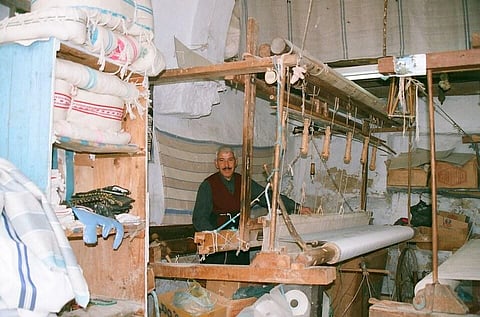
- Home
- न्यूजग्राम
- NewsGram USA
- India
- World
- Politics
- Entertainment
- Culture
- Lifestyle
- Economy
- Sports
- Sp. Coverage
- Misc.
- NewsGram Exclusive
- Jobs / Internships

New Delhi, August 7, 2017: In order to keep the country's traditions alive, and encourage people to wear hand-made loom, National Handloom Day is observed and celebrated in India on August 7. The 3rd National Handloom Day event was held in Guwahati, Assam.
This day is celebrated to remind ourselves of a 1905 Swadeshi Movement during which Indians boycotted British products in favor of the revival of domestic ones and in modern times to encourage people to wear handloom products.
Wearing Handloom is not a practice that should be celebrated for a day but it should be worn all year round to remain rooted in one's culture, tradition and to support weavers who put their years of experience, time, energy and soul into creating these pieces of art.
Bishnupur Handloom from West Bengal. Wikimedia
This year Guwahati was chosen as the venue to celebrate the 3rd National Handloom Day and to grace the occasion a documentary on handloom was also screened.
Ajay Tamta, Union Minister of State, Textiles, Sarbananda Sonowal, Chief Minister of Assam and Anant Kumar Singh, Textiles Secretary were present at the event. Ajay Tamta said that he appreciates and salutes the handloom weavers for their commitment, dedication, and skill. He said that handloom weavers should be able to earn due value for their products and that the Government is working in this direction for which various initiatives have been undertaken for the betterment of weavers such as- Hathkargha Samvardhan Sahayata Scheme and MUDRA scheme.
According to the Hathkargha Samvardhan Sahayata Scheme, the Government of India will assist the weavers by bearing 90% of the cost of new looms. As per MUDRA scheme, loans can be availed by the weavers of Rs. 50,000/- to Rs. 10 lakh without any security.
The Minister also informed that the Ministry of Textiles has entered into MoUs with Indira Gandhi National Open University (IGNOU) and National Institute of Open Schooling (NIOS) as per which children of weavers will be able to avail school and university education (with 75% of fees being borne by the Government of India). Sonowal noted that more than 50% of total weaver population of India resides in North Eastern Region, most of which are women. If the government is successful in improving the lifestyle of weavers it will empower various north eastern women and girls.
Smriti Irani, Union Textiles Minister while addressing a gathering at Ahmedabad said, the weavers will be able to derive the benefit of services like online courses, banking, passport, insurance, PAN card, voter ID and AADHAAR from Weavers' Service Centres (WSCs), from this year onwards. Another MoU was signed between Ministry of Textiles and designers. Under which, the reputed textile designers will work with handloom weavers, passing to them their design assistance and knowledge. This move is expected to improve the earnings of weavers and the market value of the handloom products.
Another MoU was signed between Ministry of Textiles and designers. Under which, the reputed textile designers will work with handloom weavers, passing to them their design assistance and knowledge. This move is expected to improve the earnings of weavers and the market value of the handloom products.
Jayasri Samyukta Iyer, fashion designer and executive committee member of the Craft Council of India, said that this year, they want to highlight three types of saree's and its revival process. Kodalli Karuppur saree belonging to Tamil Nadu, it was used in the ancient times during Thanjavur kingdom and seems non-existent now. Patteda Anchu saree belongs to Karnataka, and lastly Gauda Adivasi saree from Goa. Each of the above-mentioned saree's has an interesting history, but sadly, its relevance is fading away.
Some popular handloom fabrics are Bomkai from Subarnapur, Orissa, Mangalagiri cotton from Guntur, Andhra Pradesh, Tussar silk from Jharkhand, Paithani Brocade from Aurangabad, Maharashtra, Maheshwari from Maheshwar, Madhya Pradesh, Pochampally Ikat from Hyderabad, Andhra Pradesh and Patola weave from Patan, Gujarat.
It is high time that we come up with an initiative to improve marketing strategies for handloom sector in the country and uplift the weaver's community; also to encourage people to move away from power loom and incorporate handloom products in the form of saree's, shirts, trousers and skirts in their lives.
There is a need find ways to increase remuneration for the weavers so that they can financially support their families, the future generation is willing to take up weaving and the art of weaving can be sustained. To popularize it amongst youngsters, celebrities can wear handloom saree's, shirts, skirts, dresses and make a cool style statement out of it, influencing thousands of people at a time.
– by Kritika Dua of NewsGram. Twitter @DKritika08
NewsGram is a Chicago-based non-profit media organization. We depend upon support from our readers to maintain our objective reporting. Show your support by Donating to NewsGram. Donations to NewsGram are tax-exempt.
Click here- www.newsgram.com/donate
